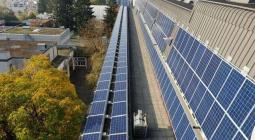The renewable energy con: how the 'clean' power you buy comes from fossil fuels.
Ηouseholds on “100pc renewable” energy tariffs may be getting as little as 3.7pc of their energy from truly green sources.
Renewable tariffs are cheaper than ever with the best energy deal on the market currently a green tariff from supplier Outfox the Market.
But consumers trying to help the planet through their energy bills may not be getting what they bargained for, according to Tom Harrison of Good Energy, a supplier that buys all its power from renewable sources.
Providers can offer green tariffs in two ways. They can buy clean energy direct from wind or solar farms or they can purchase a “renewable energy guarantee of origin” certificate (Rego) to show that they are offsetting the unclean energy they market as green. These can be bought for as little as £1.
Any generator of renewable power can apply for a Rego, issued by the Government, and then sell it on to an energy supplier. The issue, Mr Harrison said, is that a firm can buy them without purchasing the actual energy created.
This means that customers’ money does not go as far in protecting the planet from consuming non-renewable resources and combating climate change.
Mr Harrison said Regos are a “nice little marketing trick”. He called for consumers to be given all the facts to allow them to make a proper decision about how they want to spend their money.
“If you bought a green tariff you would expect your money to go towards the generator at the other end in a meaningful way,” he said. “A Rego-only tariff isn’t doing that.”
According to analysis by Good Energy, Shell Energy’s 100pc renewable tariff could get as little as 3.7pc of its power directly from renewable sources, while just half of E.On’s newly launched green tariff is made of clean power. In both cases, the remaining portion would be provided via Regos.
E.On said it provides fully renewable energy to more than half its 3.3 million customers through its own renewables business and partnerships with wind farms. It uses Rego certificates to make up the difference.
Shell Energy said it makes an annual donation to reforestation schemes, singling out two in Peru and Indonesia that work to support natural carbon.
Good Energy’s green tariffs were given a permanent exemption from regulator Ofgem’s price cap on Aug 1. Renewable deals from Ecotricity and Green Energy UK are also exempt. These are the only tariffs the regulator considers to be fully clean.
According to comparison site Uswitch, the two cheapest deals on the market are now renewable. Outfox the Market will charge the average user £846 a year while Green Energy UK charges £867. The cheapest non-renewable tariff is £873 with Orbit Energy.
But Mr Harrison cast doubt on whether a truly renewable tariff could be this affordable. Good Energy’s cheapest tariff is £1,350. He said: “You get what you pay for – how can you have a 100pc renewable tariff as the cheapest on the market? The answer is it’s not really renewable.”
Outfox uses Regos to certify its green tariffs, which draw energy from the grid, as renewable.
Cordelia Samson, of Uswitch, said it was still worth signing up for a green tariff, even if the reality might not match everyone’s expectations.
She added: “The more that suppliers can demonstrate consumer demand for green power, the more investment will go into renewable generation, while green energy tariffs themselves regularly feature at the top of the best-buy tables.”
11 August 2019
THE TELEGRAPH







